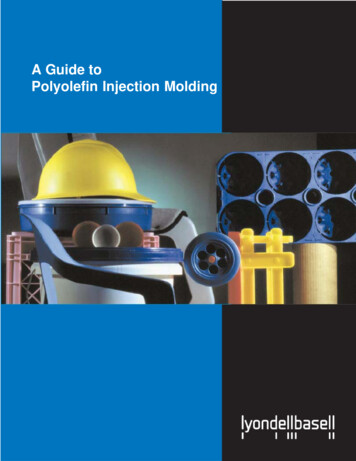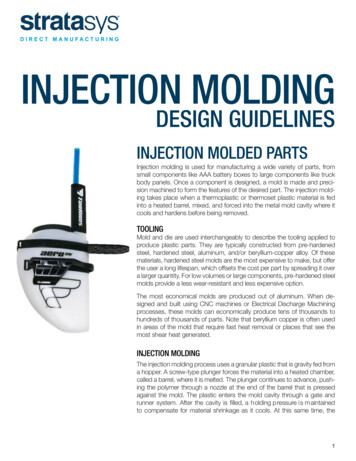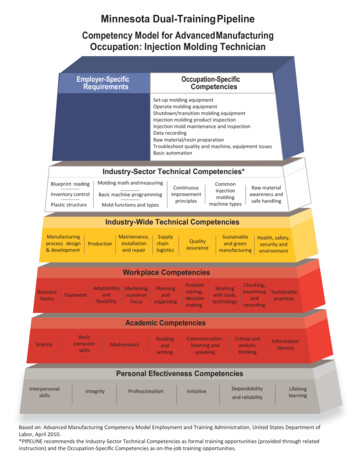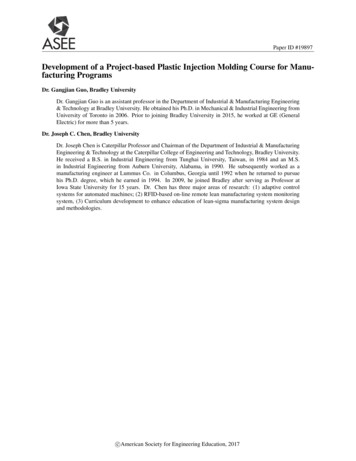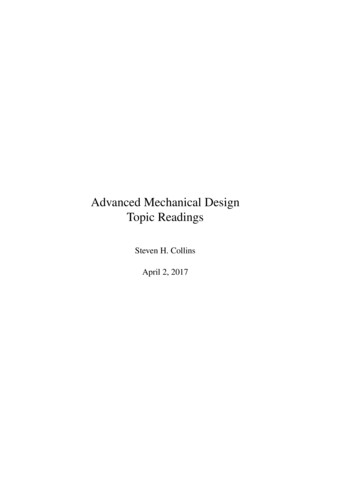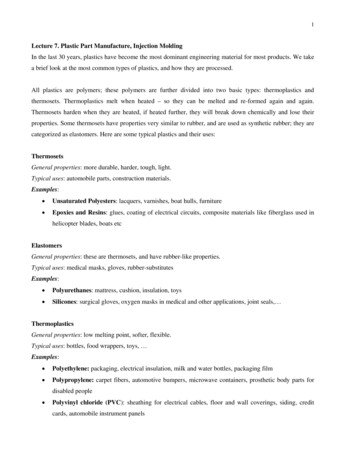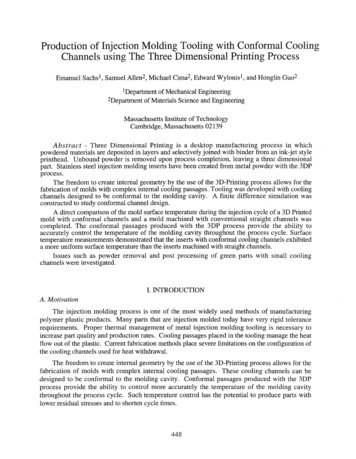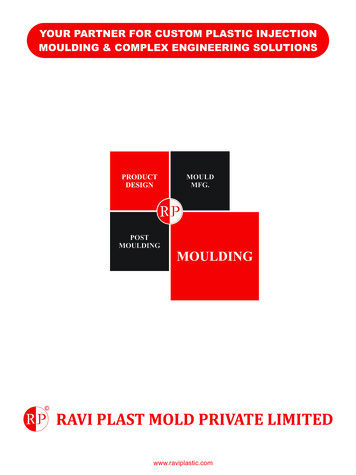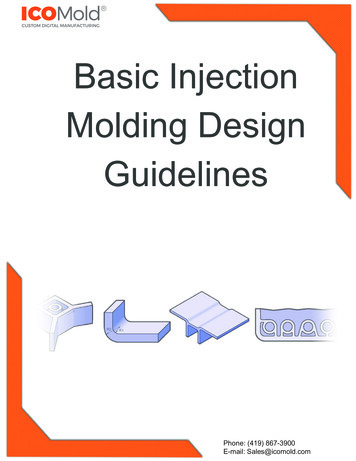
Transcription
Basic InjectionMolding DesignGuidelinesPhone: (419) 867-3900E-mail: Sales@icomold.com
Coring and Wall ThicknessCore or redesign thick areas to createa more uniform wall thickness to prevent sink or voids.Wall Thickness by Resin MaterialGuidelinesThe proper material selection and observing uniform wall thickness in injection-molded parts, helps avoid potentialissues such as sink marks and warpage.We recommended using the guidelines inthe table to the right as thicknesses varyby material:Resin / MaterialsInchesABSAcetalAcrylicLiquid Crystal PolymerLong-fiber Reinforced PlasticsNylonPC (Polycarbonate)PolyesterPolyethylenePolyphenylene SulfidePolypropylenePolystyrenePolyurethane0.045 - 0.1400.030 - 0.1200.025 - 0.5000.030 - 0.1200.075 - 1.0000.030 - 0.1150.040 - 0.1500.025 - 0.1250.030 - 0.2000.020 - 0.1800.025 - 0.1500.035 - 0.1500.080 - 0.750Phone: (419) 867-3900E-mail: Sales@icomold.com
Corner DesignMaking the outside radius one wall thickness larger than the inside radiuswill maintain constant wall thickness through corners. R2 R1 tPhone: (419) 867-3900E-mail: Sales@icomold.com
Thickness TransitionsRounding or tapering thickness transitions will minimize read-through and possibleblush or gloss differences. Additionally, blending reduces molded-in stresses andstress concentration associated with abrupt changes in thickness.Phone: (419) 867-3900E-mail: Sales@icomold.com
RibsRibs provide a means to augment strength and stiffness in molded parts withoutincreasing overall wall thickness. Other uses for ribs are as follows: Act as stops or guides for mechanisms. Ribs locate and captivate components of an assembly. They provide alignment in mating parts.Proper rib design involves five main issues: thickness, height, location, quantity,and moldability.Phone: (419) 867-3900E-mail: Sales@icomold.com
Ribs — ContinuedRib ThicknessThere are many factors that determine theappropriate rib thickness. Thick ribs oftencause sink and cosmetic problems on theopposite surface of the wall to which theyare attached. The material, rib thickness,surface texture, color, proximity to a gate,and a variety of processing conditionsdetermine the severity of sink. The illustration (right) gives common guidelines for ribthickness for a variety of materials. Theseguidelines are based upon subjective observations under common conditions and pertain to the thickness at the base of the rib.Highly glossy, critical surfaces may requirethinner ribs.Rib Location & QuantityThe location and quantity of ribs is vital inavoiding exacerbating problems the ribswere intended to correct— e.g., ribs added toincrease part strength and prevent breakagemay reduce the ability of the part to absorbimpacts without failure. Furthermore, a gridof ribs added to ensure part fatness maylead to mold-cooling difficulties and warpage.Typically much easier to add than remove,ribs should be applied sparingly in the original design and added as needed to fine tuneperformance.Phone: (419) 867-3900E-mail: Sales@icomold.com
BossesBosses find use in many part designs as points for attachment and assembly. Themost common variety consists of cylindrical projections with holes designed toreceive screws, threaded inserts, or other types of fastening hardware. Generally,the outside diameter of bosses should remain within 2.0 to 2.4 times the outsidediameter of the screw or insert.It is suggested avoiding bosses thatmerge into sidewalls because they canform thick sections that lead to sink.Proper bosses should be positionedaway from the sidewall, and if needed,use connecting ribs for support. Try using open boss designs for bosses neara standing wall.Phone: (419) 867-3900E-mail: Sales@icomold.com
Bosses — ContinuedNormally, the boss hole should extend to the base-wall level, even if the full depth is notneeded for assembly. Shallower holes can leave thick sections, resulting in sink. Deeper holes reduce the base wall thickness, leading to filling problems, knitlines, or surfaceblemishes. Because of the required draft, tall bosses (those greater than five times theiroutside diameter) can create a filling problem at their top or a thick section at their base.Additionally, the cores in tall bosses can be difficult to cool and support. Think about coringa tall boss from two sides or extending tall gussets to the standoff height instead of thanthe whole boss.Open bosses maintain uniform thickness in the attached wallPhone: (419) 867-3900E-mail: Sales@icomold.com
Draft (Draft Angles)Draft: Providing angles or tapers on product features such as walls, ribs, posts, andbosses that lie parallel to the direction of release from the mold which eases part ejection. How a specific feature is formed in a mold determines the type of draft needed.Features formed by blind holes or pockets (such as most bosses, ribs, and posts)should taper thinner as they extend into the mold. Surfaces formed by slides may notneed draft if the steel separates from the surface before ejection. Other guidelines fordesigning draft include: Draft all surfaces parallel to thedirection of mold separation. Angle walls and other attributesthat are formed in both moldhalves to assist ejection and retainuniform wall thickness. As a general rule, use the standard one degree of draft plus oneadditional degree of draft for every0.001 inch of texture depth. Use a draft angle of at least onehalf degree for most materials.Design permitting, use one degreeof draft for easy part ejection. SANresins typically require one to twodegrees of draft.Phone: (419) 867-3900E-mail: Sales@icomold.com
Guidelines The proper material selection and ob-serving uniform wall thickness in injec-tion-molded parts, helps avoid potential issues such as sink marks and warpage. We recommended using the guidelines in the table to the right as thicknesses vary by material: Resin / Materials Inches ABS
